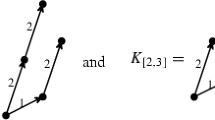Abstract
Dlab and Ringel showed that algebras being quasi-hereditary in all orders for indices of primitive idempotents becomes hereditary. So, we are interested in for which orders a given quasi-hereditary algebra is again quasi-hereditary. As a matter of fact, we consider permutations of indices, and if the algebra with permuted indices is quasi-hereditary, then we say that this permutation gives quasi-heredity. In this article, we give a criterion for adjacent transpositions giving quasi-heredity, in terms of homological conditions of standard or costandard modules over a given quasi-hereditary algebra.
Similar content being viewed by others
Availability of data and materials
All data generated or analysed during this study are included in this published article.
References
Dlab, V., Ringel, C.M.: Quasi-hereditary algebras. Ill. J. Math. 33(2), 280–291 (1989)
Coulembier, K.: The classification of blocks in bgg category O. Mathematische Zeitschrift 295(1–2), 821–837 (2020)
Flores, M., Kimura, Y., Rognerud, B.: Combinatorics of quasi-hereditary structures. J. Comb. Theory Ser. A. 187, 105559 (2022)
Dlab, V., Ringel, C.M.: The Module Theoretical Approach to Quasihereditary Algebras. Sonderforschungsbereich 343, Bielefeld (1991)
Donkin, S.: The q-Schur Algebra. Cambridge University Press, Cambridge (1998)
Mazorchuk, V., Ovsienko, S.: A pairing in homology and the category of linear complexes of tilting modules for a quasi-hereditary algebra. J Math Kyoto Univ 45(4), 711–741 (2005)
Agoston, I., Happel, D., Lukács, E., Unger, L.: Standardly stratified algebras and tilting. J Algebr 226(1), 144–160 (2000)
Acknowledgements
I would like to thank prof. Katsuhiro Uno for many helpful discussions with him and improving this article. I am also grateful to Takahide Adachi, Aaron Chan, Yuta Kimura and Mayu Tsukamoto for their valuable comments and discussions. I wish also to thank the referee for giving me a lot of advice.
Funding
No funding was received for conducting this study.
Author information
Authors and Affiliations
Contributions
Goto wrote all the manuscript.
Corresponding author
Ethics declarations
Competing interests
The authors declare no competing interests.
Additional information
Presented by: Henning Krause
Publisher's Note
Springer Nature remains neutral with regard to jurisdictional claims in published maps and institutional affiliations.
Rights and permissions
Springer Nature or its licensor (e.g. a society or other partner) holds exclusive rights to this article under a publishing agreement with the author(s) or other rightsholder(s); author self-archiving of the accepted manuscript version of this article is solely governed by the terms of such publishing agreement and applicable law.
About this article
Cite this article
Goto, Y. Criterion for Quasi-Heredity. Algebr Represent Theor (2024). https://doi.org/10.1007/s10468-024-10263-z
Received:
Accepted:
Published:
DOI: https://doi.org/10.1007/s10468-024-10263-z




